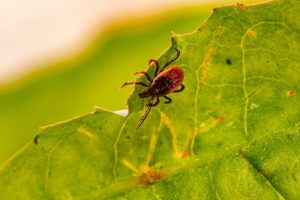
Learn what you can do to prevent tick bites and Lyme disease this summer.
As you prepare to spend more time outdoors in the summer, it is crucial to understand ticks and prevent them from biting you and your family members. Tick bites are important to prevent because they can carry numerous diseases, including Lyme disease. The Centers for Disease Control and Prevention (CDC) recently discovered that human cases of Lyme disease are more common in the U.S. than previously thought. These cases consist of about 476,000 per year instead of the 329,000 previously estimated. For Tick Awareness Week of May 10th through 16th, take the time to remind yourself of tick safety and best tick removal practices.
The Deer Tick and Lyme Disease
The deer tick (Ixodes scapularis) is found primarily in the Eastern regions of the United States. This type of tick can carry and transmit diseases like Lyme disease. A tick has to be attached for about 36 hours before a disease can be transmitted.
What to Do Before You Go Outdoors
Ticks live in grassy and wooded areas. Before you prepare to spend time in those areas, either by hiking, camping, gardening, or hunting, make sure you prepare effectively. You can do this by:
- Treating boots, clothing, and gear with products containing permethrin.
- Use EPA-registered insect repellents. Always follow the product instructions carefully.
- Tuck your pant legs into your socks to decrease the chance for tick entry.
Once you are outdoors, avoid wooded areas as much as possible, and walk in the center of trails.
After You Come Indoors
Once you come back inside from your time outdoors, you should immediately check for tick bites. You can dry your clothes on high heat for 10 minutes to kill ticks on your clothing. If your clothes require washing, use hot water.
Showering can also help wash off unattached ticks and gives you a good chance to do a tick check.
Finally, conduct a full body check. Check under the arms, around the ears, the belly button, the back of your knees, in your hair, between the legs, and around the waist.
How to Remove a Tick
If you find a tick attached to you, remove the tick as soon as possible. A simple set of fine-tipped tweezers is all you need. To remove the tick:
- Use the tweezers to grab the tick as close to the skin’s surface as possible.
- Pull upward with steady pressure. Don’t twist or jerk the tick. This can cause the mouthparts to break off and remain in your skin.
- After removing the tick, clean the area and your hands with rubbing alcohol or soap and water.
- Never crush a tick with your finger.
- You can get rid of a tick by flushing it down the toilet or putting it in alcohol. Or, you may place it in a sealed bag and save it for examination if you develop symptoms.
Symptoms of Lyme Disease
If a tick bite has infected you, the following symptoms can appear within a few weeks:
- Fever or chills
- Aches and pains, including fatigue and muscle or joint aches.
- A rash may appear within 3 to 30 days, often before the onset of fever. The rash is typically a circular rash called erythema migrans (EM). This rash occurs in 70-80% of infected people and begins at the site of a tick bite.
Early disease recognition and treatment decreases the risk of serious complications.
Scientific Plant Service Is Your Go-To Source In Landscape Healthcare
Scientific Plant Service, located in Baltimore, is a privately owned corporation, chartered in Maryland in 1957 by Frank J. Burke. We started as a full-service Arborists specializing in the care of shade trees and ornamental shrubs, but today we are a Lawn Care company that is a huge part of the community. From aquatic environments and snow management to deer and mole control, SPS has services tailored specifically for your lawn and landscape.
We offer services in Maryland, Washington, DC, and Virginia, including: Harford, Baltimore, Carroll, Frederick, Howard, Anne Arundel, Montgomery, Prince Georges, Talbot, Queen Anne’s, Calvert counties in MD, as well as Loudoun County, Fairfax County, Arlington, Alexandria, and Falls Church in VA. For more information, contact us online, or call us at 410-321-0970. Be sure to follow us on Facebook, Twitter, LinkedIn, and Pinterest!

